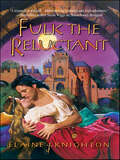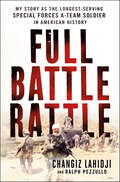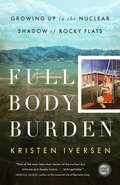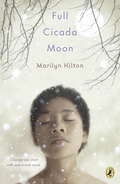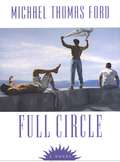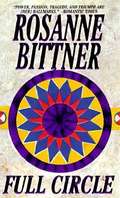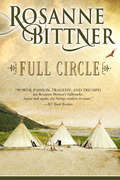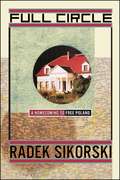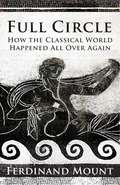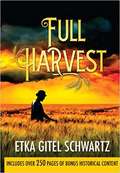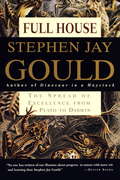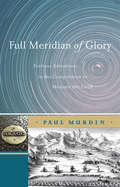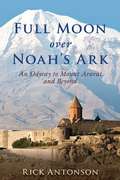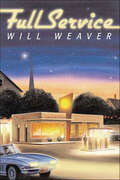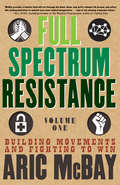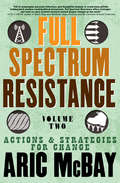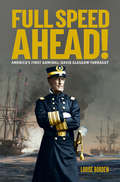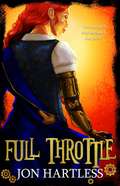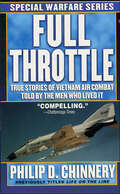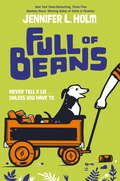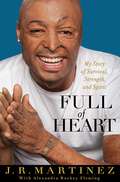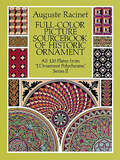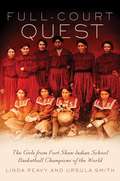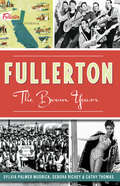- Table View
- List View
Fulk the Reluctant
by Elaine KnightonA Woman Had Laid Seige to His HeartFulk de Galliard was sore dismayed. A man of dark secrets and dangerous prowess, he was unfit to be any noblewoman’s spouse, even such a one as Jehanne of Windermere, who lived by her own knightly code. But now that the ambitions of a duplicitous earl had forced them into a betrothal, would this Iron Maiden be tempered by his touch?Sir Fulk had been the subject of many a fearsome rumor, Jehanne recalled. Now this enigmatic, overwhelming knight would be master of her keep by strength of royal command...and keeper of her heart by virtue of her own unchecked desire!
Full Battle Rattle: My Story as the Longest-Serving Special Forces A-Team Soldier in American History
by Ralph Pezzullo Changiz LahidjiOver 100 combat missions, 24 years as a Green Beret—Full Battle Rattle tells the legend of a soldier who served America in every war since Vietnam.Master Sergeant Changiz Lahidji served on Special Forces A teams longer than anyone in history, completing over a hundred combat missions in Afghanistan. Changiz is a Special Forces legend. He also happens to be the first Muslim Green Beret. Changiz served this country starting with Operation Eagle Claw in 1980, when he entered Tehran on a one-man mission to spy on Iranian soldiers guarding the US Embassy where 52 US diplomats were being held hostage. Three years later, he was in Beirut, Lebanon when a suicide car bomb exploded in front of the US Embassy killing 83 people. Weeks after that, he was shot by Hezbollah terrorists on a night mission. In Operation Iraqi Freedom, he led a convoy that was ambushed on its way to Fallujah. He was clearing houses in Mogadishu, Somalia on October, 1993 when a US Black Hawk helicopter was shot down 50 feet away from him in the incident that inspired Black Hawk Down. In 2002, he dressed as a farmer and snuck into Eastern Afghanistan and located Osama Bin Laden for the CIA. Along the way, Changiz earned numerous commendations, including the Special Forces Legion of Merit, Purple Hearts, and many others. Last year he was nominated for induction in Military Intelligence Hall of Fame and cited as “the finest noncommissioned officer to ever serve in Special Forces.” His story is an amazing tale of perseverance and courage, of combat and one man’s love of his adopted country.
Full Body Burden: Growing Up in the Nuclear Shadow of Rocky Flats
by Kristen IversenFull Body Burden is a haunting work of narrative nonfiction about a young woman, Kristen Iversen, growing up in a small Colorado town close to Rocky Flats, a secret nuclear weapons plant once designated "the most contaminated site in America." It's the story of a childhood and adolescence in the shadow of the Cold War, in a landscape at once startlingly beautiful and--unknown to those who lived there--tainted with invisible yet deadly particles of plutonium. It's also a book about the destructive power of secrets--both family and government. Her father's hidden liquor bottles, the strange cancers in children in the neighborhood, the truth about what was made at Rocky Flats (cleaning supplies, her mother guessed)--best not to inquire too deeply into any of it. But as Iversen grew older, she began to ask questions. She learned about the infamous 1969 Mother's Day fire, in which a few scraps of plutonium spontaneously ignited and--despite the desperate efforts of firefighters--came perilously close to a "criticality," the deadly blue flash that signals a nuclear chain reaction. Intense heat and radiation almost melted the roof, which nearly resulted in an explosion that would have had devastating consequences for the entire Denver metro area. Yet the only mention of the fire was on page 28 of the Rocky Mountain News, underneath a photo of the Pet of the Week. In her early thirties, Iversen even worked at Rocky Flats for a time, typing up memos in which accidents were always called "incidents."And as this memoir unfolds, it reveals itself as a brilliant work of investigative journalism--a detailed and shocking account of the government's sustained attempt to conceal the effects of the toxic and radioactive waste released by Rocky Flats, and of local residents' vain attempts to seek justice in court. Here, too, are vivid portraits of former Rocky Flats workers--from the healthy, who regard their work at the plant with pride and patriotism, to the ill or dying, who battle for compensation for cancers they got on the job. Based on extensive interviews, FBI and EPA documents, and class-action testimony, this taut, beautifully written book promises to have a very long half-life.
Full Cicada Moon
by Marilyn HiltonInside Out and Back Again meets One Crazy Summer and Brown Girl Dreaming in this novel-in-verse about fitting in and standing up for what’s right<P><P> It's 1969, and the Apollo 11 mission is getting ready to go to the moon. But for half-black, half-Japanese Mimi, moving to a predominantly white Vermont town is enough to make her feel alien. Suddenly, Mimi's appearance is all anyone notices. <P>She struggles to fit in with her classmates, even as she fights for her right to stand out by entering science competitions and joining Shop Class instead of Home Ec. <P>And even though teachers and neighbors balk at her mixed-race family and her refusals to conform, Mimi’s dreams of becoming an astronaut never fade—no matter how many times she’s told no.<P> This historical middle-grade novel is told in poems from Mimi's perspective over the course of one year in her new town, and shows readers that positive change can start with just one person speaking up.<P> <b>Jane Addams Children’s Book Honors Winner</b>
Full Circle
by Michael Thomas FordFrom the author of Looking for It, a heart attack forces three gay friends to reunite, and one to reflect on their five dramatic decades of friendship.History professor Ned Brummel is living happily with his partner of twelve years in small-town Maine when he receives a phone call from his estranged friend—Jack—telling him that another friend—Andy—is very ill and possibly near death. As Ned boards a plane to Chicago on his way to his friend&’s bedside, he embarks on another journey into memory, examining the major events and small moments that have shaped his world and his relationships with these two very different, very important men.Growing up together through the restrictive 1950s and confusing &‘60s, Jackson &“Jack&” Grace and Ned Brummel took solace in their love for each other. But once they arrive at college in 1969 and meet handsome farm boy Andy Kowalski, everything changes. Despite Andy&’s apparent heterosexuality, both Jack and Ned fall hard for him, straining their close friendship. Soon, the three men will become involved in a series of intense liaisons and bitter betrayals, coming together and flying apart, as they alternately hurt, love, shape, and heal one another over the course of years. From the heady, drug- and sex-fueled days of San Francisco in the wild seventies to the haunting specter of AIDS in the eighties and the righteous activism of the nineties, their relationship transforms and grows, reflecting the changes going on around them. Now, together again in the most crucial and intimate of settings, Ned, Jack, and Andy have another chance to confront the damage of the past and embrace the bonds of friendship and love that have stood the test of time.Praise for Full Circle &“Impactful . . . Real . . . Ford&’s beautiful story makes it all seem possible and believable . . . T
Full Circle
by Rosanne BittnerWith over 3 million copies of her books in print, Bittner now delivers a heart-stiring story set in South Dakota during the 1890s. A young missionary teacher meets a fierce Sioux brave who is everything she desires but cannot have. Fighting society's prejudices and their own doubts, will their stormtide of passion sustain them?
Full Circle
by Rosanne BittnerWith her hallmark “power, passion, tragedy, and triumph,” the award-winning author tells the story of love between a young missionary and a Sioux brave (RT Book Reviews). The year is 1892. The last thing sheltered Christian missionary Evelyn Gibbons expected upon arriving at the Standing Rock Reservation in South Dakota was to fall in love. Yet, from the moment she clashes with Black Hawk, the fiercely proud man of the Sioux, she knows he’s everything she could ever want—and everything she can never have. Living in the hills with his young son, Black Hawk reveres the ways of his people and is determined to preserve Sioux traditions. But when he meets Evelyn, a woman from the society he abhors, not even his own prejudices can smother the flame of desire that burns for her. Yet in the midst of their forbidden romance is a storm of treachery and hate that threatens to destroy their love—and their lives . . .
Full Circle: A Homecoming to Free Poland
by Radek SikorskiEveryone dreams of restoring a country home. For an American, it might be a cottage by a lake; for a Frenchman, a stone house in Provence. But for Radek Sikorski, a Polish exile living in England, the dream seemed impossible - until 1989, and the fall of Communism, when he could at last return to his native land.
Full Circle: How the Classical World Came Back to Us
by Ferdinand MountSo much about the society that is now emerging in the twenty-first century bears an astonishing resemblance to the most prominent features of what we call the classical world - its institutions, its priorities, its entertainment, its physics, its sexual morality, its food, its politics, even its religion. The ways in which we live our rich and varied lives correspond - almost eerily so - to the ways in which the Greeks and Romans lived theirs. Whether we are eating and drinking, bathing or exercising or making love, pondering, admiring or enquiring, our habits of thought and action, our diversions and concentrations recreate theirs. It is as though the 1500 years after the fall of Rome had been time out from traditional ways of being human. This eye-opening book makes us look afresh at who we are and how we got here. Full Circle is not only wonderfully witty and brilliantly astute, but also profound and often disquieting. Ferdinand Mount effortlessly peels back 2000 years of history to show how much we are like the ancients, how in ways both trivial and crucial we are them and they are us.
Full Harvest
by Etka Gitel SchwartzShe's journeyed halfway across the world to marry a man she's never met. Eighteen-year-old Gella Drozdinski arrives on the foreign plains of North Dakota afire with hope for a new life of happiness... only to find her new family haunted by sudden tragedy. As the seasons turn and change, she and the Rvorskys struggle to bridge past and present, laying old fears and secrets to rest even as an uncertain future looms. But when the daily toil of prairie life devolves into a fight for their very survival, the Rvorskys must reach beyond the limits of endurance for what might be their last, heartbreaking chance at redemption. Presented at last in novel format, the beloved story serialized in Binah Magazine now brims with over 250 pages of behind-the-scenes features and bonus historical content, including rare photos, documents, and a collection of fully annotated memoirs, as well as the previously published tie-in story Clandestined and prologue and epilogue vignettes.
Full House: The Spread of Excellence from Plato to Darwin
by Stephen Jay GouldFew would question the truism that humankind is the crowning achievement of evolution; that the defining thrust of life's history yields progress over time from the primitive and simple to the more advanced and complex; that the disappearance of .400 hitting in baseball is a fact to be bemoaned; or that identifying an existing trend can be helpful in making important life decisions. Few, that is, except Stephen Jay Gould who, in his new book Full House: The Spread of Excellence from Plato to Darwin, proves that all of these intuitive truths are, in fact, wrong. "All of these mistaken beliefs arise out of the same analytical flaw in our reasoning, our Platonic tendency to reduce a broad spectrum to a single, pinpointed essence," says Gould. "This way of thinking allows us to confirm our most ingrained biases that humans are the supreme being on this planet; that all things are inherently driven to become more complex; and that almost any subject can be expressed and understood in terms of an average." In Full House, Gould shows why a more accurate way of understanding our world (and the history of life) is to look at a given subject within its own context, to see it as a part of a spectrum of variation rather than as an isolated "thing" and then to reconceptualize trends as expansion or contraction of this "full house" of variation, and not as the progress or degeneration of an average value, or single thing. When approached in such a way, the disappearance of .400 hitting becomes a cause for celebration, signaling not a decline in greatness but instead an improvement in the overall level of play in baseball; trends become subject to suspicion, and too often, only a tool of those seeking to advance a particular agenda; and the "Age of Man" (a claim rooted in hubris, not in fact) more accurately becomes the "Age of Bacteria." "The traditional mode of thinking has led us to draw many conclusions that don't make satisfying sense," says Gould. "It tells us that .400 hitting has disappeared because batters have gotten worse, but how can that be true when record performances have improved in almost any athletic activity?" In a personal eureka!, Gould realized that we were looking at the picture backward, and that a simple conceptual inversion would resolve a number of the paradoxes of the conventional view. While Full House deftly reveals the shortcomings of the popular reasoning we apply to everyday life situations, Gould also explores his beloved realm of natural history as well. Whether debunking the myth of the successful evolution of the horse (he grants that the story still deserves distinction, but as the icon of evolutionary failure); presenting evidence that the vaunted "progress of life" is really random motion away from simple beginnings, not directed impetus toward complexity; or relegating the kingdoms of Animalai and Plantae to their proper positions on the genealogical chart for all of life (as mere twigs on one of the three bushes), Full House asks nothing less than that we reconceptualize our view of life in a fundamental way.
Full Meridian of Glory
by Paul Murdin[the text below needs editing and we must be careful not to say things about Dan Brown's book that could get Springer in legal trouble] Dan Brown's novel, The Da Vinci Code, was first published in 2003; its sales have reached 40 million worldwide. The book mixes a small spice of fact into a large dollop of fiction to create an entertaining novel of intrigue, adventure, romance, danger and conspiracy, which have been imaginatively worked together to cook up the successful bestseller. Most interest in the book's origins has centred on the sensational religious aspects. Dan Brown has written: 'All of the art, architecture, secret rituals, secret societies, all of that is historical fact.' This gives an air of authenticity to the book. Brown has, however, made up the religious doctrines, or based them on questionable accounts by others. The locations of the actions of The Da Vinci Code are not, however, made up. The present book is the scientific story behind the scene of several of the book's actions that take place on the axis of France that passes through Paris. The Paris Meridian is the name of this location. It is the line running north-south through the astronomical observatory in Paris. One of the original intentions behind the founding of the Paris Observatory was to determine and measure this line. The French government financed the Paris Academy of Sciences to do so in the seventeenth to nineteenth centuries. It employed both astronomers - people who study and measure the stars - and geodesists - people who study and measure the Earth. This book is about what they did and why. It is a true story behind Dan Brown's fiction. This is the first English language presentation of this historical material. It is attractively written and it features the story of the community of scientists who created the Paris Meridian. They knew each other well - some were members of the same families, in one case of four generations. Like scientists everywhere they collaborated and formed alliances; they also split into warring factions and squabbled. They travelled to foreign countries, somehow transcending the national and political disputes, as scientists do now, their eyes fixed on ideas of accuracy, truth and objective, enduring values - save where the reception given to their own work is concerned, when some became blind to high ideals and descended into petty politics. To establish the Paris Meridian, the scientists endured hardship, survived danger and gloried in amazing adventures during a time of turmoil in Europe, the French Revolution and the Napoleonic War between France and Spain. Some were accused of witchcraft. Some of their associates lost their heads on the guillotine. Some died of disease. Some won honour and fame. One became the Head of State in France, albeit for no more than a few weeks. Some found dangerous love in foreign countries. One scientist killed in self defence when attacked by a jealous lover, another was himself killed by a jealous lover, a third brought back a woman to France and then jilted her, whereupon she joined a convent. The scientists worked on practical problems of interest to the government and to the people. They also worked on one of the important intellectual problems of the time, a problem of great interest to their fellow scientists all over the world, nothing less than the theory of universal gravitation. They succeeded in their intellectual work, while touching politics and the affairs of state. Their endeavours have left their marks on the landscape, in art and in literature.
Full Moon over Noah's Ark: An Odyssey to Mount Ararat and Beyond
by Rick AntonsonAcclaimed travel writer Rick Antonson sets his adventurous compass on Mount Ararat, exploring the region’s long history, religious mysteries, and complex politics.Mount Ararat is the most fabled mountain in the world. For millennia this massif in eastern Turkey has been rumored as the resting place of Noah’s Ark following the Great Flood. But it also plays a significant role in the longstanding conflict between Turkey and Armenia.Author Rick Antonson joined a five-member expedition to the mountain’s nearly 17,000-foot summit, trekking alongside a contingent of Armenians, for whom Mount Ararat is the stolen symbol of their country. Antonson weaves vivid historical anecdote with unexpected travel vignettes, whether tracing earlier mountaineering attempts on the peak, recounting the genocide of Armenians and its unresolved debate, or depicting the Kurds’ ambitions for their own nation’s borders, which some say should include Mount Ararat.What unfolds in Full Moon Over Noah’s Ark is one man’s odyssey, a tale told through many stories. Starting with the flooding of the Black Sea in 5600 BCE, through to the Epic of Gilgamesh and the contrasting narratives of the Great Flood known to followers of the Judaic, Christian and Islamic religions, Full Moon Over Noah’s Ark takes readers along with Antonson through the shadows and broad landscapes of Turkey, Iraq, Iran and Armenia, shedding light on a troubled but fascinating area of the world.Skyhorse Publishing, as well as our Arcade imprint, are proud to publish a broad range of books for readers interested in history--books about World War II, the Third Reich, Hitler and his henchmen, the JFK assassination, conspiracies, the American Civil War, the American Revolution, gladiators, Vikings, ancient Rome, medieval times, the old West, and much more. While not every title we publish becomes a New York Times bestseller or a national bestseller, we are committed to books on subjects that are sometimes overlooked and to authors whose work might not otherwise find a home.
Full Service
by Will WeaverThe times they are a-changin' . . .The summer that Paul turns sixteen his mother pushes him to take a job in town instead of just working on the family farm. "You need to meet the public," she says, which is saying a lot for a woman deeply committed to the tightly knit religious community to which they belong. And meet the public Paul does: He meets Kirk, the angry gas station manager; Harry, a reclusive and kindly gangster; and a family of hippies passing in a yellow peace van to San Francisco. He also meets beautiful Peggy, a high school sensation, and dark-haired Dale, her onthe-side boyfriend who is headed to Vietnam. All of them come to the station – as well as girls on summer vacation, tanned and smelling of coconut oil, and ministers from Paul's fundamentalist church, who are worried about his soul. As the summer progresses, Paul learns the secrets of his small Minnesota town and discovers that he's ready to have a few secrets of his own.With richly developed characters and a flair for arresting imagery, Will Weaver tells the story of the end of one boy's innocence, unfolding at a time when the country as a whole is undergoing a difficult, deeply disturbing coming-of-age.
Full Spectrum Dominance: U. S. Power in Iraq and Beyond (Open Media Series)
by Rahul MahajanIn this compelling big-picture assessment of the U.S. war on Iraq, Mahajan combines his experience as an anti-Iraq sanctions activist with a keen analysis of U.S. foreign policy in the post-Cold War era to provide the analysis that has been overlooked in the mainstream debate. Situating Iraq within the larger context of post-9/11 foreign policy, he analyzes the Bush National Security Strategy and the new neoconservative vision of achieving increasing degrees of global domination and control. Presented with unflinching clarity, Mahajan's research demonstrates that the war on Iraq was part of a much larger plan, assembled before 9/11 and, as stated by the Project for a New American Century, needing only a "new Pearl Harbor" to implement it.
Full Spectrum Resistance, Volume One: Building Movements and Fighting to Win
by Aric McBayA guide to direct action for those disillusioned with the posturing of liberal “activism.”The radical left is losing, but it doesn’t have to be that way. Here is the radical’s guide to activist work—the manual we need at this crucial moment to organize for universal human rights, a habitable earth, and a more egalitarian society. Thoroughly exploring the achievements and failures of radical movements throughout history—from 19th-century anti-colonial rebellions in China and the environmental actions of First Nations and Native American tribes throughout the 20th century, to Black Lives Matter and the fight for Gay Liberation—the two volumes of Full Spectrum Resistance candidly advocate for direct action, not just risk-averse models of protest marches and call-ins. With in-depth histories and case studies of social justice and environmental movements, noted writer, activist, and farmer Aric McBay explains why passive resistance alone cannot work, and how we must be prepared to do whatever it takes to create substantial social change. In Volume 1: Building Movements and Fighting to Win, McBay describes the need for resistance movements, and paints a portrait of what a thriving resistance movement might look like today. Citing successful movements such as the Deacons of Defense of the American Civil Rights Movement, the anti-colonial revolutions in Guinea and Cape Verde, and activist groups like Act-UP, McBay deftly illustrates how to organize activist groups and encourage enlistment, while also noting the necessary precautions one must take to secure these radical circles from infiltration and collapse.
Full Spectrum Resistance, Volume Two: Actions and Strategies for Change
by Aric McBayA guide to direct action for those disillusioned with the posturing of liberal “activism.”The radical left is losing, but it doesn’t have to be that way. Here is the radical’s guide to activist work—the manual we need at this crucial moment to organize for universal human rights, a habitable earth, and a more egalitarian society. Thoroughly exploring the achievements and failures of radical movements throughout history—from 19th-century anti-colonial rebellions in China and the environmental actions of First Nations and Native American tribes throughout the 20th century, to Black Lives Matter and the fight for Gay Liberation—the two volumes of Full Spectrum Resistance candidly advocate for direct action, not just risk-averse models of protest marches and call-ins. With in-depth histories and case studies of social justice and environmental movements, noted writer, activist, and farmer Aric McBay explains why passive resistance alone cannot work, and how we must be prepared to do whatever it takes to create substantial social change. In Volume 2: Actions and Strategies for Change, McBay uses the successful strategies of various actions, such as the Greek Resisters of the 2008 Greek Television Takeover, to articulate the best practices for inter-activist coordination and communication with mass media to effectively spread message. Covering reconnaissance methods and other forms of intelligence-gathering, Volume 2 guides the reader in smart decision-making and damage control, such as how to recover from both covert and overt adversarial attacks, such as COINTELPRO (1971). Moreover, this manual clearly articulates the best strategies and practices for the financial, logistical, and tactical organization necessary to all successful radical movements in the long term.
Full Speed Ahead!: America's First Admiral: David Glasgow Farragut
by Louise BordenDiscover the man behind everyone's favorite call to action, "Full speed ahead!" in this inspiring and engaging biography about the first Admiral of the United States Navy, David Glasgow Farragut.At the age of nine, David Glasgow Farragut was appointed a midshipman in the US Navy by President James Madison. It was the start of a celebrated career. Farragut sailed aboard ships along the Delaware River, in the Caribbean, and across the Atlantic Ocean, even rounding the tip of South America, all while rising through the naval ranks from midshipman to admiral. When the Civil War began, Captain Farragut dedicated his life to protecting the United States as it was being torn in two. When President Lincoln asked him to capture New Orleans, the city Farragut once called home, and later to take Mobile Bay, the officer had only one order for his fleet: Full speed ahead! Noted nonfiction writer Louise Borden's in-depth research uncovers a man dedicated to his country -- a man who earned the title of America's first admiral.
Full Throttle
by Jon HartlessIn a world that refuses to let her move forward, can Poppy stay ahead of the pack? In an alternative Edwardian era, steam-powered marvels are a common occurrence. Airships fill the sky, steam-powered automobiles race across the land, and television, computers and are already an emergent technology. However, these inventions are only for a privileged few, as those lower down the social ladder struggle to get by without even the most basic of necessities. Sixteen-year old Poppy Orpington seems destined for a life of near-poverty until her father perfects a petrol-fuelled racing engine. Their early successes allow Poppy to gain a new prosthetic arm, allowing to her to gain the mobility she's desired all her life. But can a working class family crack open the aristocratic world of motor racing? Can Poppy overcome prejudice and social conformity as she fights to find a place in the world? Or will the ruling elite crush her only chance of a better life?
Full Throttle: True Stories of Vietnam Air Combat Told by the Men Who Lived It (Special Warfare Series)
by Philip D. ChinneryAirmen in Vietnam weren't above the hell of war-but they went beyond the call of duty.It was America's longest, most withering war, as hellish in the air as it was on the ground. But little has been told of the airmen who fought, who died, who lived and dared to remember...until now. Three dozen airmen tell their secret stories of the air war in Vietnam the only way it ought to be told: in their own words. In this brutally accurate picture of brave men fighting a tragic war-a portrait that touches upon every branch of the armed forces-aviation journalist Philip D. Chinnery's Full Throttle finally honors the heroes who have been nearly forgotten.
Full of Beans
by Jennifer L. HolmNewbery Honor Book Turtle in Paradise is beloved by readers, and now they can return to this wonderful world through the eyes of Turtle's cousin Beans. <P><P>Grown-ups lie. That's one truth Beans knows for sure. He and his gang know how to spot a whopper a mile away, because they are the savviest bunch of barefoot conchs (that means "locals") in all of Key West. Not that Beans really minds; it's 1934, the middle of the Great Depression. <P>With no jobs on the island, and no money anywhere, who can really blame the grown-ups for telling a few tales? <P>Besides, Beans isn't anyone's fool. In fact, he has plans. Big plans. And the consequences might surprise even Beans himself. <P><b> Winner of the Scott O'Dell Award for Historical Fiction </b>
Full of Heart: My Story of Survival, Strength, and Spirit
by J. R. Martinez Alexandra Rockey FlemingAn inspirational journey from tragedy to triumph In 2003, nineteen-year-old Private J. R. Martinez was on a routine patrol when the Humvee he was driving hit an antitank mine in Iraq, resulting in severe injuries and burns on his face and more than one-third of his body. Out of that tragedy came an improbable journey of inspiration, motivation, and dreams come true. In Full of Heart, Martinez shares his story in intimate detail, from his upbringing in the American South and his time in the Army to his recovery and the indomitable spirit that has made him an inspiration to countless fans. J. R. Martinez always had a strong spirit. Raised in Bossier City, Louisiana, and then Hope, Arkansas, by a single mother from El Salvador, he was well known at school for his good looks and his smart mouth. At seventeen, showing an early determination and drive that would become one of his trademark qualities, J. R. convinced his mom to move to Dalton, Georgia, where he believed he would have a better chance of being recruited to play college football. His positive attitude earned him a spot on a competitive high school football squad, but when his college dreams collapsed, he turned to the U. S. Army. A few months later, he found himself serving in Iraq. When J. R. 's humvee hit a mine and exploded--just one month into his deployment--he was immediately evacuated to a San Antonio medical center, where he spent the next thirty-four months in grueling recovery. Seeing his disfigured face for the first time after the accident threw him into a crushing period of confusion and anger. His spirits were low, until he was asked to speak to another young burn victim. J. R. realized how valuable and gratifying it was to share his experiences with other patients and listen to theirs. He'd found a calling. His fellow soldiers, along with the local and then national media, soon latched onto J. R. 's spirit and strength. His resilience, optimism, and charm were also noted by Hollywood and scored him roles on All My Children and Dancing with the Stars, where he was the season thirteen champion. Today, J. R. tours the country sharing his story and his lessons for overcoming challenges and embracing hope, lessons that abound in this book. Full of Heart is an unforgettable story of a man who never gave up on his dreams. After being injured in Iraq, J. R. Martinez became a motivational speaker, actor, and winner of season thirteen of Dancing with the Stars. Martinez lives in Los Angeles
Full-Color Picture Sourcebook of Historic Ornament: All 120 Plates from "L'Ornement Polychrome," Series II (Dover Fine Art, History of Art)
by Auguste RacinetClassic sourcebook of spectacular royalty-free design collages, featuring over 1,500 decorative elements and motifs from major cultures in history through the 19th century, from Asia and Africa to Europe and the Americas. Adapted from jewelry, illuminated manuscripts, weapons, tiles, carved wood panels, ceilings, inlay, hardware, ceramics and more.
Full-Court Quest: The Girls From Fort Shaw Indian School Basketball Champions of the World
by Ursula Smith Linda PeavyMost fans of women's basketball would be startled to learn that girls' teams were making their mark more than a century ago--and that none was more prominent than a team from an isolated Indian boarding school in Montana. Playing like "lambent flames" across the polished floors of dance halls, armories, and gymnasiums, the girls from Fort Shaw stormed the state to emerge as Montana's first basketball champions. Taking their game to the 1904 St. Louis World's Fair, these young women introduced an international audience to the fledgling game and returned home with a trophy declaring them champions. World champions. And yet their triumphs were forgotten--until Linda Peavy and Ursula Smith chanced upon a team photo and embarked on a ten-year journey of discovery. Their in-depth research and extensive collaboration with the teammates' descendents and tribal kin have resulted in a narrative as entertaining as it is authentic. Full-Court Quest offers a rare glimpse into American Indian life and into the world of women's basketball before "girls' rules" temporarily shackled the sport.
Fullerton: The Boom Years
by Cathy Thomas Sylvia Palmer Mudrick Debora RicheyAmerica enjoyed newfound prosperity in the decades following World War II, and Southern California was an epicenter of postwar growth. Among the many Orange County communities that grew and flourished in this hopeful and exciting era, Fullerton led the way. Join authors Sylvia Palmer Mudrick, Debora Richey and Cathy Thomas as they recount Fullerton's boom years. It was a time characterized by economic growth, vibrant development and engaged civic participation. From the founding of the world-famous Fender guitar company to the establishment of Fullerton's first university, discover the events and people that transformed Fullerton from a small town to a thriving city.
